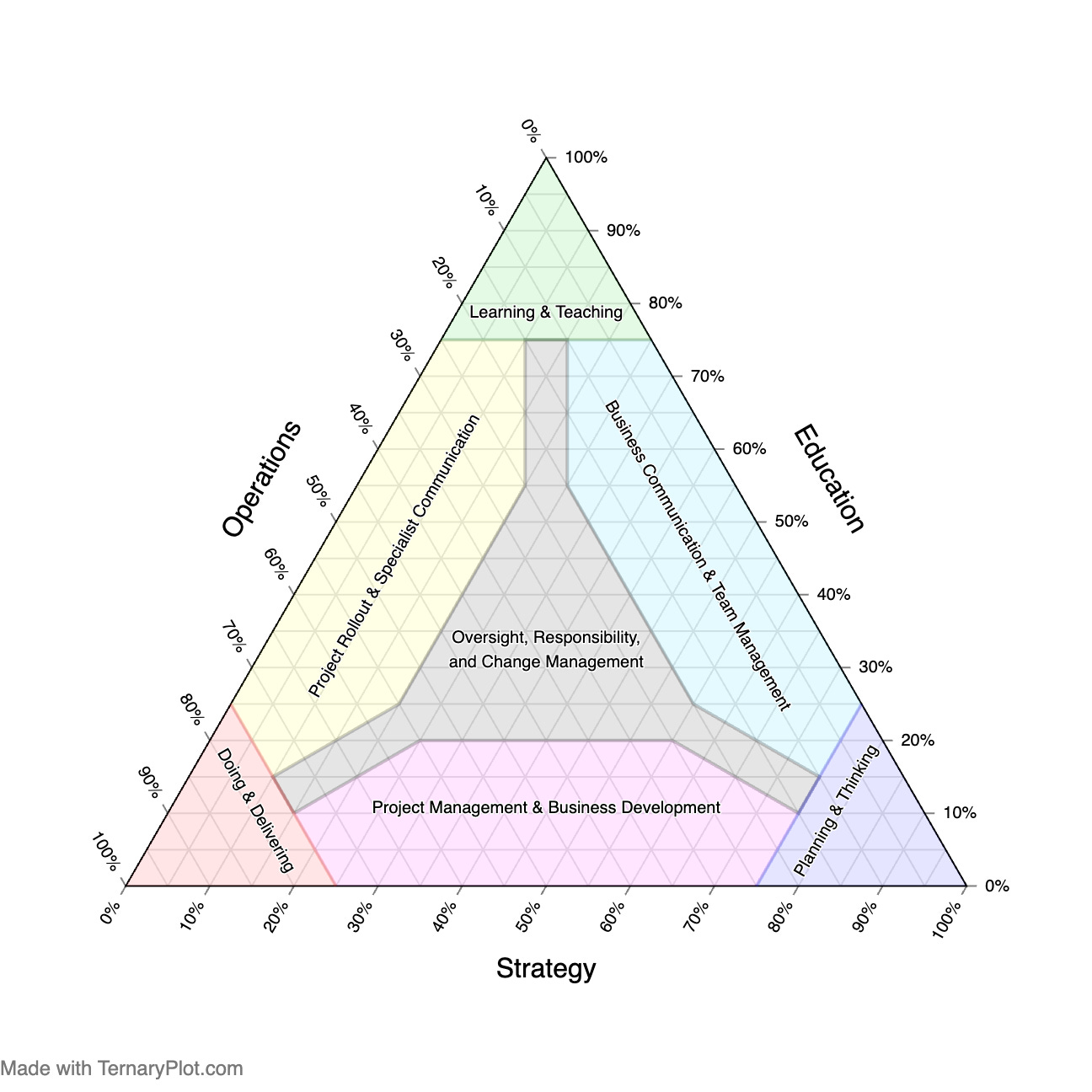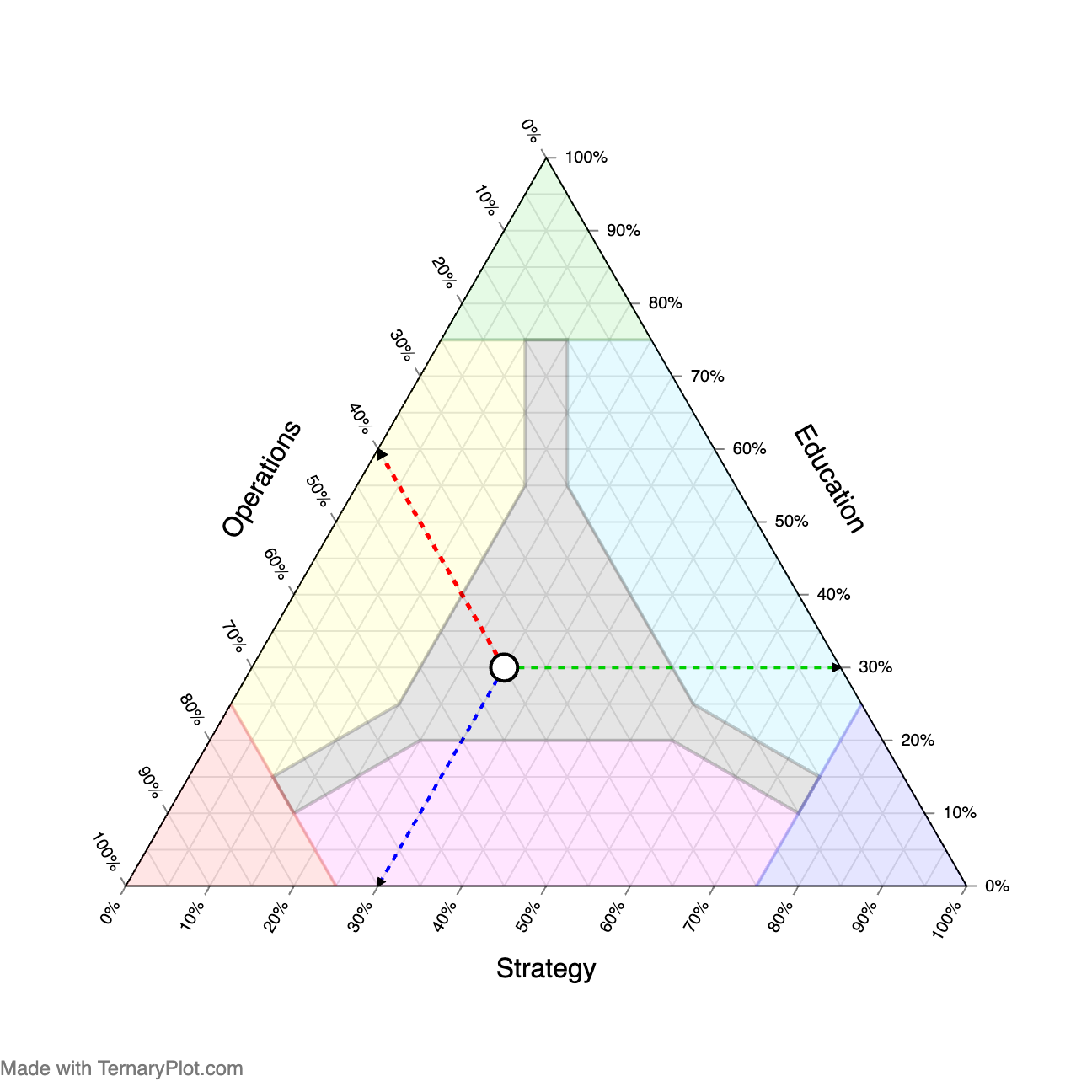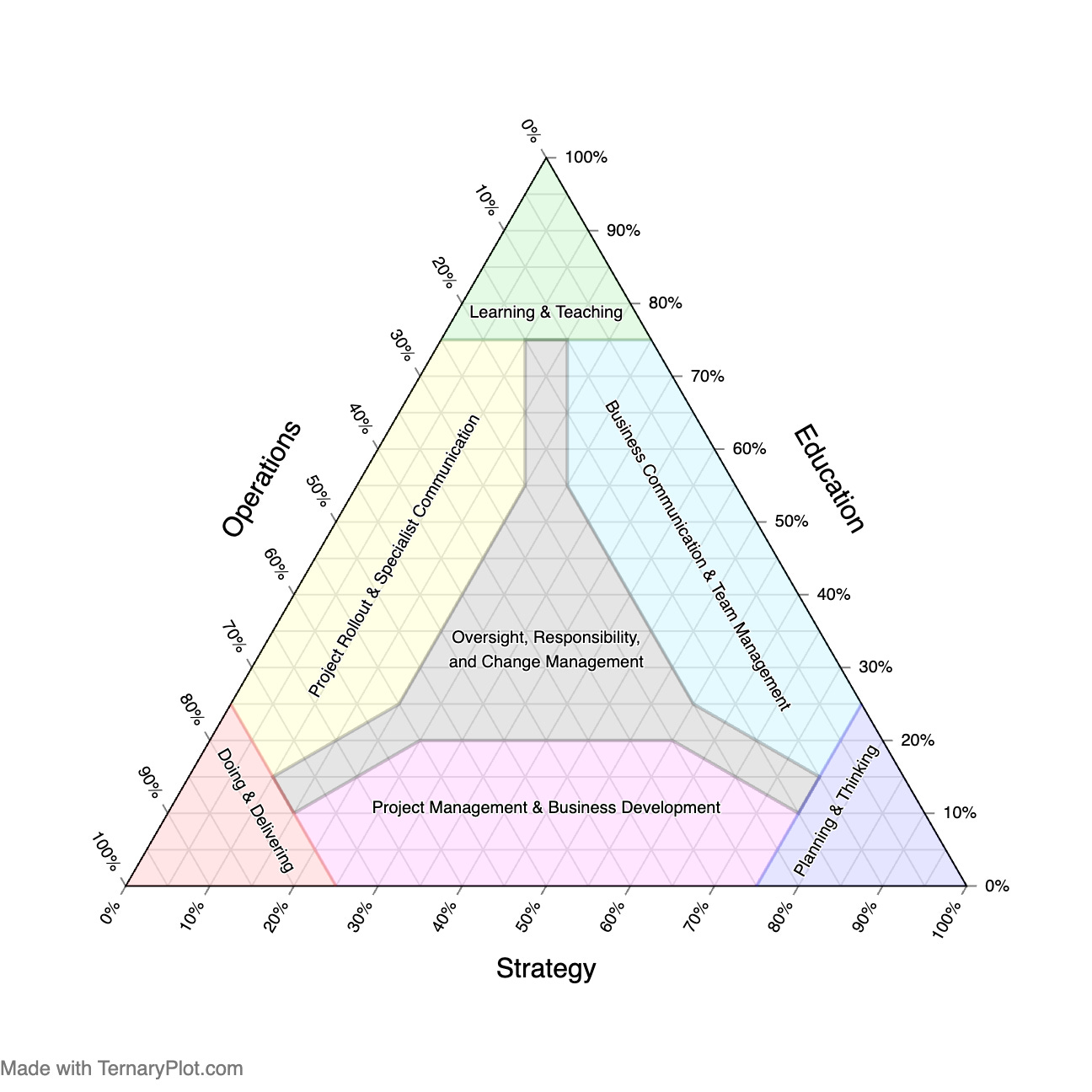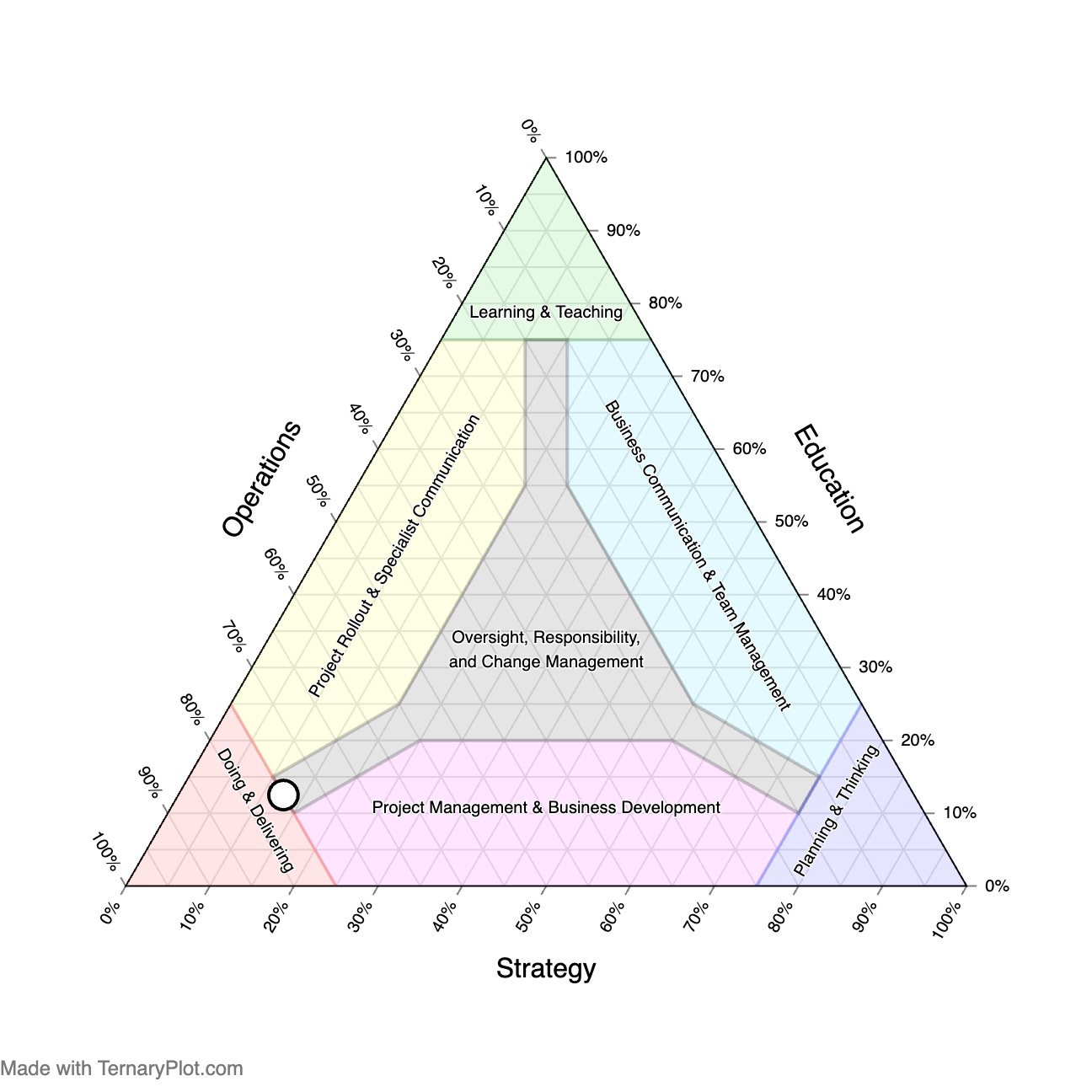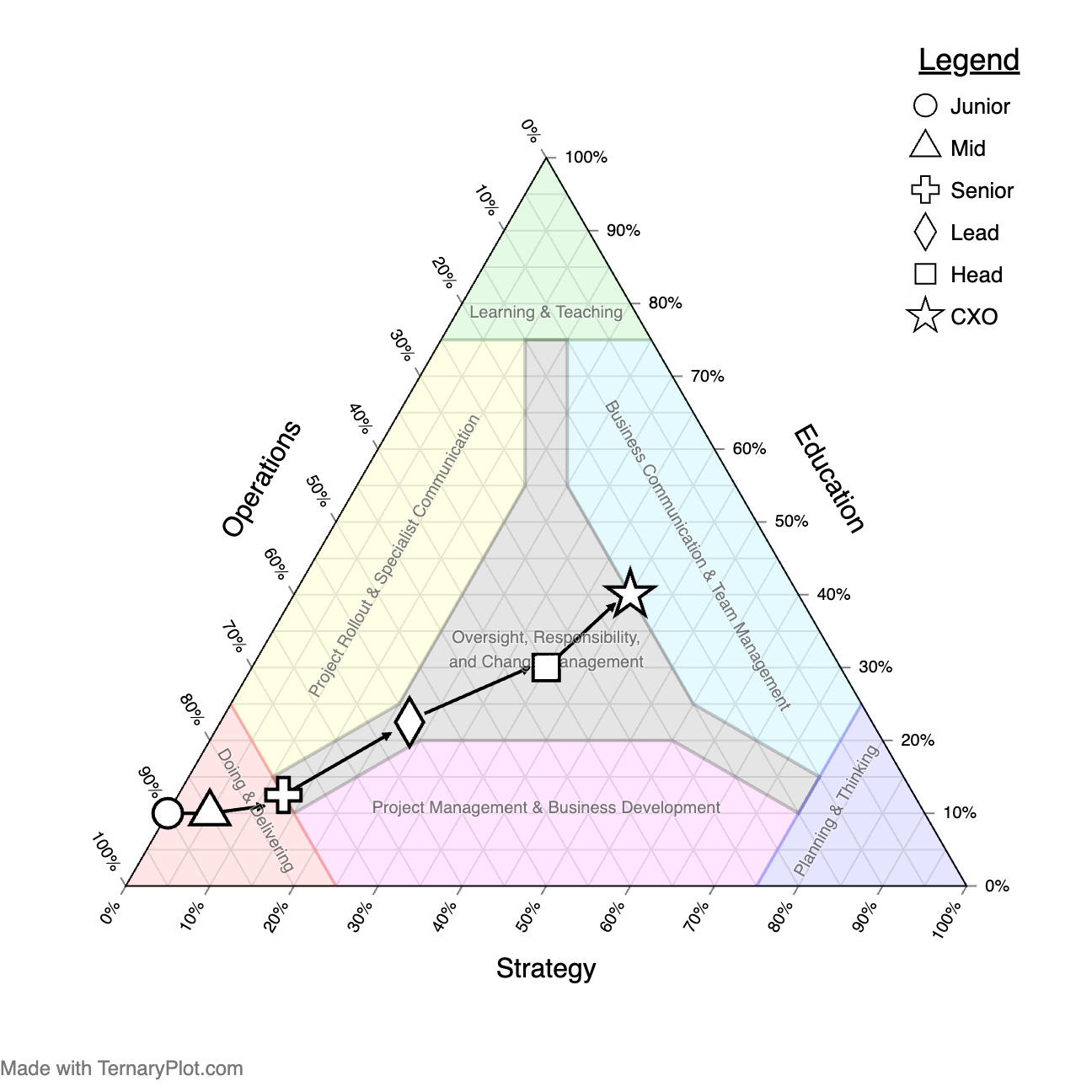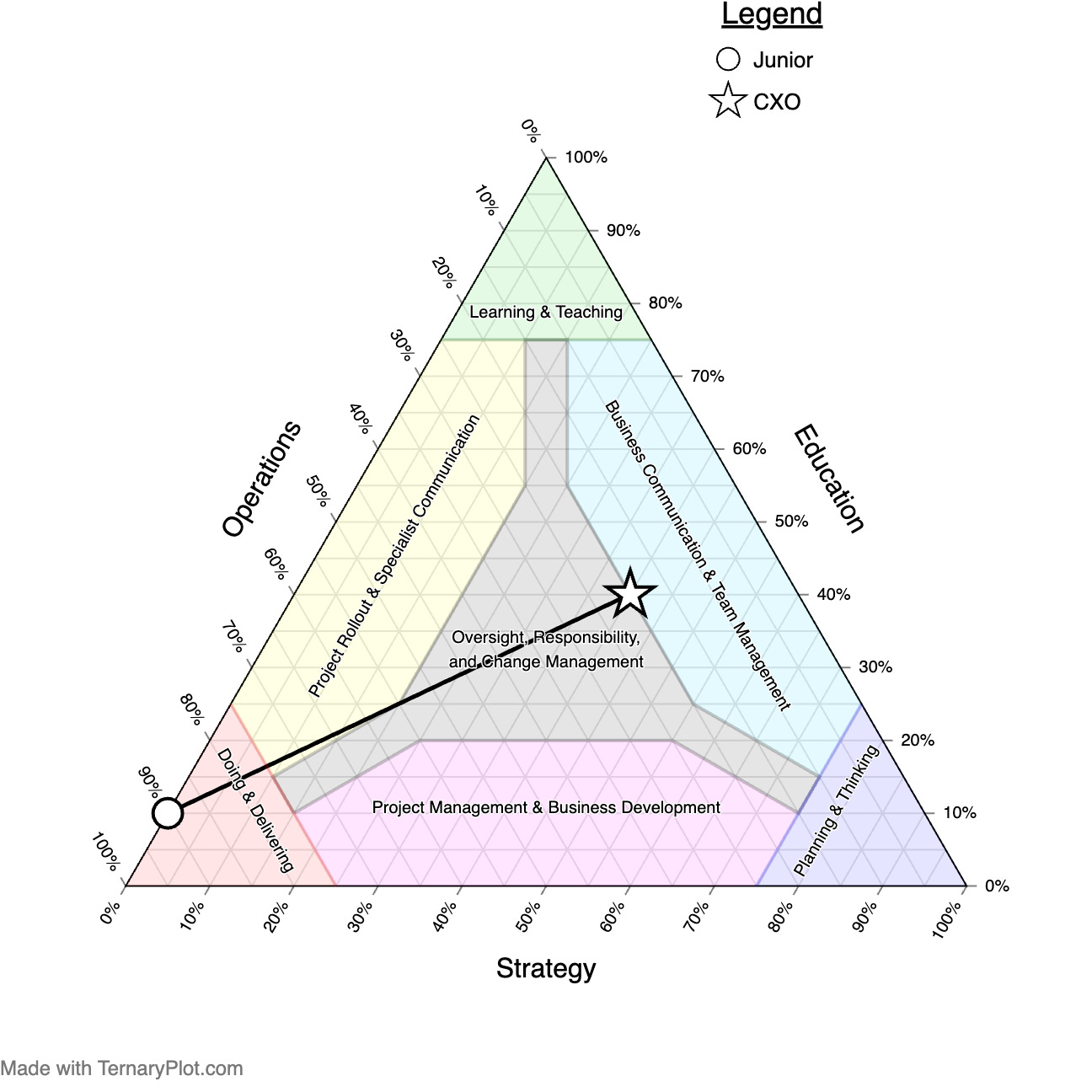The Business Trinity Theory
Introducing the compass for your professional journey.
Over the years, in different roles and businesses, I have developed a theory regarding business operations which I call “The Business Trinity.”
The Business Trinity Theory
Every role, project, and objective in a business can be represented as a combination of how much time is spent on the following core elements in order to deliver value for the business:
Operations: Tasks focused on delivery or the completion of work
Education: Tasks focused on personal learning or teaching others
Strategy: Tasks focused on planning or preparation
For example: A Junior Data Scientist will most spend most of their time with the following breakdown: {Operations: 90%, Education: 10%, Strategy: 0%}; this is because the majority of their responsibilities are on the delivery of projects, with some time put aside for learning additional skills.
N.B. This isn’t to say this is what I think the breakdown should be, but rather a representation of what the average breakdown is.
With the Business Trinity, once you are able to classify what the breakdown of a role, project, or objective within a business is, you unlock powerful information that can inform: time management, career growth, talent acquisition, and other business activities.
These abilities are exceptionally powerful in project management, and will be explored further when we introduce “The Cycles of Discovery & Innovation” and combine these two concepts in future posts.
To be updated when these posts go live, if they aren’t already, you can do so by subscribing.
Where the Business Trinity becomes even more powerful is when you identify what the combination of the core elements – Operations, Education, and Strategy – means to business activities, as then you can start to see what results this allocation of time or resources can generate.
Visualising The Business Trinity
Since the core component breakdown of the Business Trinity – Operations, Education, and Strategy – is percentage based, we can easily use a type of plot called a “ternary plot” to represent this and so, I present “The Business Trinity Compass”.
The Business Trinity Compass represents the core component breakdown, and highlights zones associated to relevant business activities.
Each zone highlights the expected range for the core components breakdown, summarises the class of key business activities this breakdown will focus on, and therefore its associated business outcomes.
So for any breakdown of the core components we can visualise: what the associated tasks are likely to be; what we are likely to accomplish; and through inverting this thinking, if we want to focus the business on a class of activity, what the breakdown of the core components should be.
Not only can the Business Trinity Compass be used as a powerful time and project management tool, but when applied to individuals we get both a career growth and development tool that can help identify opportunities to realise these ambitions; as well as a tool that can help identify the responsibilities required by the business for talent acquisition and hiring.
We get these abilities as a result of the Business Trinity theory because we have a clear understanding of what we are wanting to accomplish – and what it will take to accomplish – by being able to define the core component breakdown: i.e. how much importance are we placing on Operations, Education, and Strategy.
How do we use “The Business Trinity Compass”?
As we mentioned the Business Trinity Compass is a type plot called a “ternary plot” - named because it has three axes. We’ll run through a quick example as to how to read it; also, the website I’ve used to make it has an interactive explainer which is quite good and you can read that here.
First, let’s talk about the axes. Each axis on the chart ranges from 0%–100%; and each of the three axes on the Business Trinity Compass has a direction it needs to be read, as indicated by the tick marks on the axis. For the Business Trinity Compass, the direction for each axis and its associated core component is:
Operations: Up and to the left
Education: Straight to the right
Strategy: Down and to the left
So, if from a point on the graph you follow those directions, you will get to the value for each of the core components. If the line that you’re following doesn’t match the direction of the tick mark on the axis, you have gone the wrong way – in that case, go the other way to find the value and associated core component.
Let’s say we have an objective with a core element breakdown identified as: {Operations: 40%, Education: 30%, Strategy: 30%}. This would appear on the Business Trinity Compass like so (I have removed the zone labels to make it easier to read the compass for this example):
You can see from the lines we have added, originating from our example point, that by reading the compass from this point we get:
Up and to the left: Operations = 40%
Straight right: Education = 30%
Down and to the left: Strategy = 30%
This falls into the “Oversight, Responsibility, and Change Management” zone as it is a combination of all three core components - Operations, Education, and Strategy.
Now let’s talk about the zones on the compass. There are seven zones which are grouped into either “focused” or “central” zones, and these are defined by ranges of values for the core components.
Let’s start with the definition for “focused” zones; and reshow the compass with labels for convenience.
Doing & Delivering
With a primary focus on Operations, this zone is about delivering work that reaches the business goal.
Learning & Teaching
With a primary focus on Education, this zone is about training; either other people within the business, or your own personal development.
Planning & Thinking
With a primary focus on Strategy, this zone is about planning and thinking about opportunities for business growth.
The use of zones on the Business Trinity Compass highlights the inherent flexibility in the core components when these activities take place between businesses, and this flexibility is inherent in the types of activity so the zones need to reflect this. The zones also help us to understand, by their neighbours, what other business actions we may need to consider in order to achieve our goals.
With that in mind, let’s discuss the “central” zones of the Business Trinity Compass. These central zones highlight the aspects of business activities where the core component breakdown is more balanced, and are often the zones where business leaders spend most of their time.
Project Rollout & Specialist Communication
With a split focus between Operations and Education, this zone is about deploying the work that has been completed within the business; as well as communicating specialist information within the business to ensure understanding and facilitate the effective performance of their responsibilities.
Business Communication & Team Management
With a split focus on Education and Strategy, this zone is about communicating the strategies within the business, highlighting the value they bring; as well as managing and mentoring teams to help them grow and develop; whilst reaching high levels of performance along the way.
Project Management & Business Development
With a split focus on Operations and Strategy, this zone is about the management of project delivery to ensure quality and time targets are met; as well as on deploying initiatives that will improve the businesses ability, or enable the business to realise more opportunities, in order to realise the business’ vision and goals,
Oversight, Responsibility, and Change Management
With an equal importance on all components, or where the position on the compass is between two central zones, this zone is about making sure the business, as well as the teams within it, both realises and expands the opportunities available to it. This is done through a range of methods, and where necessary, the zones described in the Business Trinity Compass.
If you find that the breakdown of the core components is directly on a border, very near to a border, or sits in the “Oversight, Responsibility, and Change Management” channels, then this should be read as a member of all of the nearby zones.
For example, let’s take the role of a “hands on” Head of Engineering in a Start Up environment. This will most likely have a core component breakdown of {Operations: 75%, Education: 12.5%, Strategy: 12.5%} and look like this:
This point for the “hands on” Head of Engineering sits at the intersection of “Doing & Delivering” and the channel of “Oversight, Responsibility, and “Change Management” that separates “Project Rollout & Specialist Communication” and “Project Management & Business Development” – which, I can tell you from experience as a “hands on Head” in a Start Up, is spot on.
Such a role spends a lot of time coding and delivering the MVP, while at the same time balancing project management and how this MVP will affect business growth with the other senior business leaders. Then, once the MVP is ready, you are responsible for ensuring the rollout is understood by the key business functions such as sales and marketing. All the while, because you most likely understand the limitations and abilities of the product more than anyone else in the business, you have to ensure that you: set expectations of the business accordingly, manage pressures from the business on the product development, and ensure the MVP is aligned with any relevant legislation or governing requirements.
When you get comfortable with the Business Trinity Compass, you can use it to identify the responsibilities of a role and place any role on the compass easily, which also makes the compass a useful tool for hiring.
Let’s go back to the “hands on” Head of Engineering role; this person won’t stay at this position on the compass as the business grows, as their time allocation will shift towards a more traditional Head of Department role. So, how does the Business Trinity Compass help across your career?
The Business Trinity across your career
To exemplify the flexibility of the Business Trinity Compass, let’s consider the journey of a technical role from Junior to CXO.
You can see from this compass that as seniority progresses, less time is spent on delivery – and they quickly move out of the “Doing & Delivering”-focused zone. More time is then spent in the central zones, with increased importance on Education and Strategy.
You can also see how the “Hands in Head” role lines up with a senior position which in my experience is accurate at the start of such positions.
An important aspect to note, especially when it comes to technical roles, is how the type of “Operations” changes over time. When you are a junior in a technical role, operations relates to coding; however, as seniority progresses, “Operations” – which is about “Doing and Delivering” – relates more to delivering the strategy for the business, rather than the technical definition i.e. coding. The senior role still requires an amount of “Operations”, but the operations are being done are not the same as they were when they were more junior.
This also highlights how the Business Trinity Compass is useful with regards to resourcing and talent acquisition; every time a person is promoted, their focus changes. We need to then ensure that the business needs are met, whilst the core component breakdown for that person changes.
Through visualising this career journey, we can start to see how the Business Trinity Compass can be used as a career management tool.
Using the Business Trinity Compass as a guide to career management tool
If you think to yourself, “I don’t know what I should be doing to progress my career”, we suggest that you can use the Business Trinity in two ways:
Get your manager, or a senior figure whose role you aspire towards, to place their role on the compass. By drawing a straight line from where you are on the compass to where they are, you can get an indication as to the skills that you need to develop.
Look at the neighbouring zones to where you currently are, and look to improve your skills in these areas through training or looking to get more involved in your day to day activities.
For example I have created the Junior to CXO line on a compass below. The line crosses through “Project Rollout & Specialist Communication” as well as “Oversight, Responsibility, and Change Management”. So in this situation they should look for opportunities where they can be more involved in the implementation of the tools they are developing. Also since “Project Management & Business Development” is adjacent to their position and “Business Communication & Team Management” is part the CXO’s position on the compass, they should look for opportunities in these areas where possible. They might not get to act on all of these opportunities but it useful to start creating a Learning and Development plan to get to where they want in their career.
Knowing where you need to improve your skills is not a detriment. Saying “I don’t know” can be the three most powerful words – especially when combined with “…but I’ll try to find out”. The Business Trinity Compass can be a tool that helps you find answers.
Not everyone wants to be a CXO or leader in a business, and that is perfectly fine! However, learning the skills surrounding your current position will make your day-to-day activities easier, and most likely raise your profile within the business.
More times than not, your day-to-day responsibilities in a business will be more than your job specification outlines. Earlier in my career, before I created the theory of the Business Trinity, I had a team member who wanted to do more Machine Learning Operations work but didn’t have time to do so due to other business responsibilities.
If I had the Business Trinity Compass, I could have: asked them to break down their current activities into the core components, i.e. the amount of time spent on Operations, Education, and Strategy; see where they were spending their time; and looked at creating a journey that brought them back towards “Doing & Delivering”.
This is important is because any change in someone’s activities creates a vacuum that needs filled. If we don’t do this, then the person is inevitably brought back to the activities they wanted to stop doing. Through the identification of the core component breakdowns for where they were and where they wanted to get to, we could identify the percentage of their time that we would lose on these responsibilities and need filled by other members of the business, or through further hires.
Through the business trinity compass we could easily identify the opportunities needed to make adjustments to their responsibilities, and start the journey towards where they wanted to be.
How the Business Trinity theory applies in your day-to-day activities
When it comes to day to day activities I see the Business Trinity Theory being valuable in two key symbiotic ways:
Time Management: With the breakdown of the core components you obtain a breakdown that can be easily applied to the amount of time you should spend doing each component, as it relates to your role – for example: {Operations: 50%, Education: 20%, Strategy: 30%}. So if you are spending more than 30% of your time in meetings, or more than 20% of your time training people, you know that you are over-indexing on these aspects, and need to scale these back in order to meet your objectives and responsibilities.
Project Planning: Let’s say you have a client deliverable due in 2 weeks, and you break it into the Business Trinity’s core components like this: {Operations: 70%, Education: 0%, Strategy: 30%}; and you estimate that in total it will take 120 person hours to complete. Through the Business Trinity you have an initial estimate as to what resource you will need; so in our example: 84 Operations Hours and 36 Strategy Hours. Now here’s where the magic happens, take the resource you have and place them on the compass with their current responsibilities; for a 40 hour working week you have roughly 30 productive hours per person, so multiply their component breakdowns by 30 to get their available hours. This will tell you whether you have enough people to deliver this project in the time frame; enabling you to either: allocate staff effectively, redefine the scope to fit in the available hours; push back the delivery to get more time; or bring in external resource to help with the delivery.
Project and time management are critical to ensure business productivity and prevent burnout; both for you and your team. Fundamentally through using the Business Trinity you can put forward cases that are reasoned and defensible to ensure a successful project.
Considerations and Extensions
This post has not only introduced the Business Trinity Theory, and the Business Trinity Compass; but also shown how it can be used in businesses to support the goals the business wants to achieve in a range of use cases.
However, like all business frameworks these are suggestions of use and not limitations; they may be used in additional ways that have not been mentioned in this post.
For example, in the next post we will discuss “The Cycles of Discovery & Innovation” which outlines the stages of any new idea, or concept, in practice; and how to balance day-to-day requirements with creating something new.
Once we have introduced “The Cycles of Discovery & Innovation” we will return to the Business Trinity theory and extend it even further by showing how through the combination of the two principles we unlock more areas on the Business Trinity Compass; highlighting the types of activities that are associated with the central zones.
The last point I want to make is that I chose to introduce this early in the Technician’s MBA because we are going to use the zone names, plus “Definitions”, “Examples”, and a couple of others we grow - such as the areas we will introduce shortly - as tags for this stack. So if there is a particular area you are interested in learning more about you can go directly to it as we will categorise each post into the relevant zones when we post.
Make sure you are subscribed to get notified so you don’t miss these or other posts when posts go live every Wednesday!
Let us know if and how you use the Business Trinity Compass, or if you have any questions, in the comments. However, with that we will finish this post and see you next Wednesday.
Grand. Thanks for your time.



